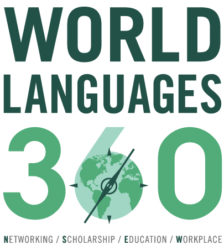Mini Grant Pilot Program Awards Announcement
We are thrilled to announce the recipients of our Mini Grant Pilot Program awards! Please join us in celebrating the following projects that are underway with the support of World Languages 360. All proposals met the program’s requirements, two of which are a clear alignment to at least one of our Compass Points and an agreement to publish, share, or present the findings in an educational publication or at a professional conference, or to share the resulting product or app. Below you will find excerpted and lightly edited portions of the successful proposals.
Integrating AI, Art, and History in Language Learning (Smith College)
This study will focus on the use of AI that can convert a text to a voice to demonstrate learners gains of the language abilities and knowledge. The AI tool the Micmonster, is a free tool and learners can access it easily. This study will present pedagogical implications and emerging themes in the future research of AI-based language learning methodology. The procedure will include giving authentic readings in Arabic to summaries. These readings will be based on a historical place, games, and other topics that have an influence in history. The student will create an art work similar to the selected reading. The main goals are to have students use the language in creative way and involve in a project as a team, and link their experience to real world situation. The students will remember this experience because they will create and plan. The teachers will learn from this experience and use it in their classes as a new approach in teaching language that involves different field of knowledge.
Expanding Horizons at MGA: Recruiting for a Strong Program (Middle Georgia State University)
We are planning a multi-faceted approach:
A. Identifying students who are doing well in our language classes and sending them an email (for online students) or a formal letter (for in-person students) letting them know how adding a language credential could benefit them and letting them know exactly how many classes they would have to take.
B. We also plan on finding key partners across campus, i.e. faculty, advisors, staff, ready to champion languages and our programs.
C. Host large recruitments events on our two main campuses (we have 5 campuses) in fall 2024 and spring 2025. We would like to have activities that can get students interested in the languages we offer:
• Activities/games focused on learning some basic words and phrases in French, Spanish, and Korean.
• Activities/games introducing students to the benefits of learning a second language for their careers and personal lives.
• Promotional material with our course offerings and degree options.
We would also work with our advising center so that a professional advisor can be present to register students for the language class they are interested in on the spot.
D. Finally, we would like to find a bilingual STEM speaker to host another event on what learning and knowing another language has done for their career.
Unleashing the Potential of ChatGPT in Curriculum Development and Lesson Planning (Foreign Service Institute, Global Language Center)
This project revolves around the role of ChatGPT 3.5 (free version) in the landscape of language education development. This project uncovers practical instances of leveraging ChatGPT 3.5 to craft comprehensive and effective lesson plans. The project explores the specific commands utilized during the research process, shedding light on the invaluable benefits derived from integrating ChatGPT 3.5 (free version) into the realms of curriculum and material development.
The project aims to illustrate insights through tangible examples across Farsi, Russian, Czech, and Slovak languages. This illustration delves into the steps undertaken to achieve results, underpinned by a discussion of the invaluable lessons gathered from this journey.
The primary objective is to share this enriching experience with a diverse audience, including educators, curriculum designers, and AI developers. The project findings not only stand to benefit ChatGPT users but also hold immense potential for language curricula and instructional practices thereby contributing significantly to the educators’ development community.
The Open Source Language Placement Project (Northeastern University)
The idea is to create an Open Source placement test for languages that is easily modifiable on a departmental level. There are many products out there that aren’t adjustable to different curriculums. Many also do not take into account dialectal variation, heritage learners, or multilingual repertoires that can often confound results. Also, instructors can often not see specific results and are left with having to do follow-up testing, which prevents the process from being transparent and efficient, when instructors already have so many other responsibilities. I want to create a meaningful type of placement that can be adapted to many languages and that works to fill in gaps that are currently present. Lastly, this placement exam should be able to communicate with university systems that oversee prerequisites (via API) to create an easy and responsible registration process.
Cross-linguistic Impact of iSpraak on Pronunciation Acquisition (Saint Louis University)
It has been noted in the literature that computer assisted pronunciation in general, and automatic speech recognition in particular, offer the most promise in enhancing learner speech (Golonka et al., 2014), and previous research we conducted (García et al., 2020) showed that iSpraak leads to specific types of pronunciation gains in second-semester Spanish students. The current research project extends previous work to new student populations by including third-semester Spanish students, and fourth-semester French students. Data collection began in January 2024 and will continue to May 2025.
Open Portal for Language Courses (Denison University)
Since costs of language books and the internet codes associated with them are so expensive, I am looking for ways to lower the economic burden for our students and, at the same time, give them a powerful tool to continue practicing Spanish outside the classroom. I am doing this to support open source books and affordable content for Spanish (and for other languages as well). My project consists of creating a website with a database with AI capabilities that provides students with assignments about different grammatical points. The artificial intelligence will give feedback and potentially grade those assignments based on specific rubrics. Moreover, this website will also contain a repository of assignments created by professors in the Department of Modern Languages with the help of AI agents. Additionally, this website will have a conversational chatbot in the target language with a text-to-speech functionality.
Come back soon for information on our next round of grant opportunities!
Mini Grant Initiative – All Grants Have Been Awarded for this Pilot Cycle as of May 23, 2024 (click for details)
Will 2023 be a Critical Juncture?

One wonders whether people living at a time of a significant turning point always realize it. Certainly, a major political upheaval or the onset of a war present themselves unmistakably, but there are other more evolutionary and gradual changes—even profound ones—that do not start off with a bang. The COVID years started off with such a bang, but we’re still in those COVID years. Colleagues with whom we were beginning to collaborate on language learning in professional and workplace settings suddenly hit the brakes with a thud and, like it or not, found themselves ramping up to teach remotely (or to support that teaching and learning).
So almost 2 years ago, we adjusted our endeavors and suspended the main thrust of our mission and, to use contemporary parlance, we pivoted. During COVID, we focused our efforts on supporting our colleagues.
But are we post-COVID teaching and learning yet? We’re still living with COVID and although in-person teaching and learning is back, learning with synchronous and asynchronous technology-enhanced options for outside of the classroom hasn’t vanished. Can we live with both? Do they need to be separated? Or is hyflex the answer? Now that we’ve all experienced some sort of technology-dependent instruction, does the future amalgamate in-person, online, and hyflex/hybrid?
What about VR and AR, which seem to be nearing the point where they are affordable and available?
How do we do these things without widening the technology gap?
If we can tackle these questions, and we begin to see movement and cohesion in research and praxis, then yes, we can say that we are living at the time of a significant turning point in world languages teaching and learning.
We are excited at these prospects and have expanded our mission and efforts accordingly. You can read more under About World Languages 360.
Meanwhile, our previous focus and enthusiasm for language learning in workplace and professional settings remains undaunted. We are thrilled to support ACTFL’s latest special interest group, the Language for Specific Purposes SIG. This represents a significant step forward in the wider profession taking up the leadership mantle in language learning outside of (in addition to) the traditional classroom space. You can read a concise description at the link below.
If you are an ACTFL member, please consider signing on to ACTFL’s new LSP SIG https://www.actfl.org/connect/special-interest-groups/new-sig-support
Using Technology for Speaking Practice for Virtual or Remote Learning
We Invite you to Take a Deeper Dive into Online Teaching and Learning in the World Languages Classroom
World Languages 360 Redirects Its Mission Due to COVID-19
What do Workers with Second Language (L2) Proficiency Bring to the Workplace Party? Part 2: Managers and Leaders
(click the title above to expand and submit your own comment)
In the first part of this 2-part article, the focus was decidedly on employees and the skills that they bring to the workplace. As a reminder, a Google survey of its employees and their perceptions produced results that were somewhat surprising, with technical skills ranking well below those we arguably attribute in spades to bilinguals and polyglots. There are 7 such “soft skills” and attributes that topped the list. Take a look here.
Thinking about an important subset of employees, one whose ranks many employees wish to join, it may prove a useful exercise to highlight some of the attributes and perspectives of managers and leaders, and then to engage in a similar side-by-side comparison of those with our handy research summary from the American Council on the Teaching of Foreign Languages (ACTFL), as discussed in Part 1.
Before addressing that directly, it is important to differentiate between “managing” and “leading.” There are numerous articles ranging from opinion pieces to bona fide, published, peer-reviewed academic research on the matter, but for the purposes of a useful framework, take a look at this article in INC. online. The author, James Kerr, proposes 10 distinctions between the perspectives and even skill sets required by leadership and management, in an organization. Ideally, the optimal employee in a leadership role possesses the ability to do both items in each numbered, contrasting set.
Back to Google, then: What about management skills and traits? What else did Google discover? While the results are hardly surprising, they reiterate outlooks and perspectives that manifest caring and connections among people first and foremost.
In sum, the “soft” skills that we associate with effective leaders and effective managers, correlate well with successful language learners. Empathy, listening for cultural perspective as well as factual content, and negotiation of meaning all characterize successful target language interactions. Want proof? Look at some of the exemplars in the NCSSFL-ACTFL Can-Do Statements. While these are not meant to be a checklist of assessment criteria, taken as a whole, they provide a window into what our profession values as high performance among language learners. Arguably, these are an exquisite window into the underlying empathy and “soft skills” that appear in Google’s Oxygen Project discussed above. Some examples that illustrate not only linguistic competency, but also give a window into valuable leadership qualities include:
“I can interact and negotiate to resolve highly abstract and complex matters in culturally appropriate ways on a wide variety of topics and to persuasively advocate a point of view that is not necessarily my own.” (Interpersonal Communication, Distinguished)
“In my own and other cultures I can analyze how practices within informal and formal situations are related to perspectives.” (Intercultural Communication, Superior)
“I can tailor language to a variety of audiences by adapting my speech and register in culturally authentic ways.” (Interpersonal Communication, Distinguished)
The list goes on, and the parallels are there for the drawing. So, what do you think? Are there other explicit and implicit values that our profession infuses and imbues into World Languages teaching and learning that easily translate into success in an organizational setting? Have you come across other resources linking the two?
What do Workers with Second Language (L2) Proficiency Bring to the STEM Workplace Party? Part 1: Employees
(click the title above to expand and submit your own comment)
What is STEM and why is it so dominant? As you probably know, STEM is an acronym for Science, Technology, Engineering, and Math. Along with a few fortunate Humanities disciplines such as English, or Social Science classes, they tend to form the core of required curricula in the K-12 world and even in some university general education requirements. STEM disciplines are seen as reliable, solid, serious, challenging, and career-launching. Perhaps you’ve seen reports or heard mention in the news that there always seems to be a shortfall of learners pursuing these critical disciplines, leaving jobs unfilled and making those who do work in these fields able to command attractive and competitive salaries. Educational policy nationally in the United States has favored STEM in the past few years, and this has radiated out to the K-12 world in states and into higher education as well.
So, where does that leave World Languages, and what are the concerns of World Languages educators? While some languages are considered to be critical and less commonly taught, and those corresponding to national security concerns can prove attractive to learners, generally speaking these educators feel themselves on the outside looking in at a party to which only scientists, employers, and policy-makers have been invited. To an extent, the emphasis on certain disciplines because they are perceived to lead to employment (after all, higher education is so pricey), does make sense. Student loan debt is no laughing matter, and some economists have begun to express a public fear that widespread collapse of student loan debt could be the next economic bubble to burst. To continue the party motif, it is the potential equivalent of a police raid that shuts the entire thing down.
The perceived commoditization of higher education, the recent push to link community college funding and new programs to employment, those Bureau of Labor Statistics (BLS) data overly emphasized, and ample resistance by faculty at Research 1 universities whose education and research center around time-honored fields such as literature and linguistics, cause many faculty on the front lines of language teaching and learning to lament their perceived marginalization. The challenges to attracting and retaining World Languages teachers are well-established.
What are the concerns of employers? Among the myriad factors that give them pause as they survey the labor pool, there is perhaps one constant: it’s easier to hire for skills that directly match the tasks in which employees will engage directly. Managers, particularly hiring managers, prefer to find employees grounded in fields of study that correlated to the central activities of their division or overall organization. They have limited time to train, and even less time to evaluate and mentor employees in amorphous traits such as “empathy” or “critical thinking.” Those are nice to have, employees with credentials and experience are expected to come through the door with them in hand, and they’ll hope to address them as soon as the next looming deadline passes. Or, they’ll be rolled into the performance evaluation process as SMART goals.
So, one might expect that a Google study of its employees would show that indeed, technical skills are paramount, and grounding in STEM disciplines would outweigh the aforementioned soft skills and attributes. In fact, that is not the case.
What does the Google study show? In fact, there are 7 such “soft skills” and attributes that topped the list. Take a look here.
Enter the World Languages profession. As organizations such as the American Council on the Teaching of Foreign Languages (ACTFL) begin to widen their efforts and focus toward concepts such as Career Readiness and Global Competence, they are keenly aware of the need to contextualize their arguments about the benefits of L2 learning in a sound, research context. Take a look at ACTFL’s summary of “What the Research Shows.”
Other observers have been quick to correlate the positive attributes of language learners and their propensity for success in employment. For example, this very topic has been well-summarized and even expanded upon by Transparent Language, proposing that learners of World Languages are uniquely positioned to bring these perspectives and skills into the workplace.
So, what do you think? Do the research-identified benefits of language learning correlate to the traits, perspectives, and soft skills that emerged in the study of Google’s employees? Can other disciplines make this claim, legitimately?
Coming soon, we’ll continue this with a similar comparison of what Google’s study has to say about managers, and those attributes and skills of successful World Languages learners.


